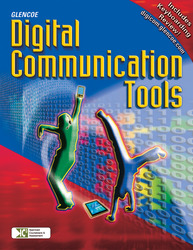 
Digital Communication ToolsChapter 12:
PresentationsAdditional ActivitiesScience Project Objective
Investigate a topic of interest. Use the steps of the scientific process to develop a hypothesis, create an experiment, analyze the data, and draw conclusions. Then create a PowerPoint presentation to share your process and conclusions.
Materials
Computer with Microsoft PowerPoint installed
Any materials you need to conduct your investigations/experiments
Procedure - Review the steps of the scientific process as a class.
- Ask questions that could be answered using the scientific process. If you need help, use the Internet to look for possible topics.
- Take digital pictures of the steps in your process to include in your PowerPoint presentations.
- Share your data in class. Work in groups to draw conclusions about your findings.
- Create PowerPoint presentations that show the process you used to find the information. Include charts, graphs or tables to show information found during the investigation.
Extension
Share your PowerPoint presentation with the class. Discuss the various conclusions. Do you still have questions regarding the experiment?
History of Math Objective
Examine the historical context in which mathematical theories were formulated. Create PowerPoint presentations giving the historical background on these theories.
Materials
Computer with Microsoft PowerPoint and Internet access
Texts containing information on the history of different mathematical theories
Procedure - Think of significant mathematical theories that you have studied in class and in previous classes.
- Pick one of these theories to research. You may work either individually or in small groups.
- Find the historical context in which these theories were formulated. You may want to focus on the person credited with the idea or on the period in history in which the idea was formulated.
- Create a PowerPoint presentation to share the information you have gathered. Use graphs, charts, graphics, or tables to illustrate the ideas you are presenting.
- Present your PowerPoint presentation to the class.
Extension
Contact mathematical researchers at local universities to find out what current mathematical ideas are being researched. If possible, interview these researchers to find out about their educational background and why they became interested in the advanced study of mathematics.
Historical Viewpoints Objective
Understand the many varied viewpoints surrounding an event in history. Create a PowerPoint presentation to represent one viewpoint of a historical event.
Materials
Computer with Microsoft PowerPoint and Internet access
Texts containing information about historical events
Procedure - Focus on one event in history and brainstorm the different viewpoints and opinions of the people living during that event in history.
- Adopt a viewpoint and research it. Why did people have this viewpoint? What would people who shared that perspective do to promote their ideas? How did these people feel about the outcome of the event?
- Create a PowerPoint presentation sharing the information you learned while completing your research into that viewpoint. Include photographs, primary documents, political cartoons, or other artifacts from that time. You may find these on the Internet, or you may need to scan these artifacts in order to incorporate them into the PowerPoint presentation.
- Share your presentation with your classmates.
Extension
As a class, create a forum in which the different viewpoints are debated and discussed. You might consider acting as a person with the viewpoint you researched. |  |
|

















